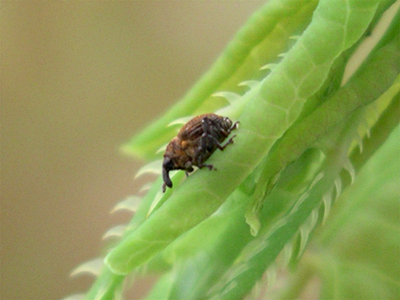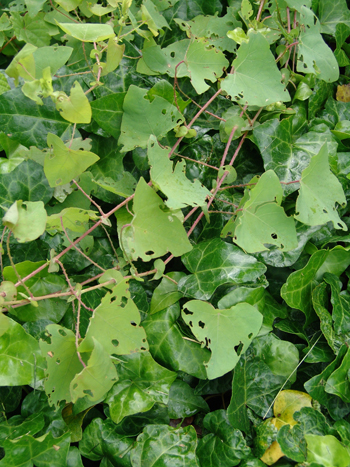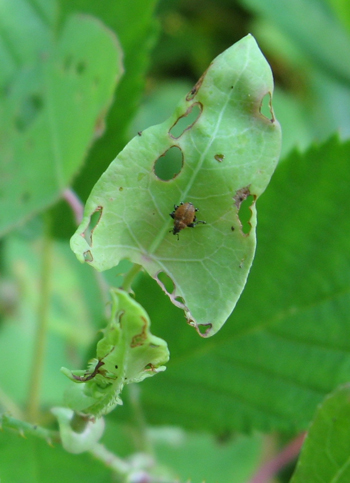Excited about Weevils

We are excited about weevils at the Scott Arboretum. The stem-boring weevil, Rhinoncomimus latipes, has been found throughout the Arboretum nibbling on the invasive mile-a-minute weed, Polygonum perfoliatum.
Mile-a-minute weed is an annual Asian vine that has invaded habitats in the northeastern US: forested floodplains, streamside herbaceous wetlands, and upland forests. It can be found growing along the Crum Creek, in the Crum Woods, and on banks throughout the campus.
This prickly, branching vine germinates in April in the Mid-Atlantic region and proceeds to rapidly climb over other plants. It produces iridescent blue berry-like achenes in the beginning of mid-summer, completing its cycle with the killing frost in the fall. The next generation of this annual vine is spread by birds, mammals, and water. The seed which germinates underneath established plants requires a cold period for germination and can last for 3 years in the seed bank.
In an effort to control this invasive, the Forest Service initiated a biological control program in 1996 with host specificity tests conducted in China and in quarantine conditions in Delaware. This small, black stem-boring weevil eats small holes in the leaves of mile-a-minute vine. In the field, the adults are often found at terminals of the plant. Eggs laid in leaves and stems hatch larvae that bore into the stem. After completing development, they exit the stem and drop to the soil to pupate.

Damage to mile-a-minute vine by weevils. photo credit: R. Robert
The Forest Service trials identified the stem-boring weevil, Rhinoncomimus latipes, as host-specific to mile-a-minute vine. This is exciting because unlike the virus released to control the invasive Rosa multiflora, it will not to spread to other plants, particularly cultivated plants. While the weevils do not outright kill the invasive vine, they severely set the plant back.

Weevil eating mile-a-minute vine. photo credit: E. Lake
In 2008, Ellen Lake, a Ph.D. student at University of Delaware, visited the Scott Arboretum to release these beneficial weevils in the Crum Woods. Upon arrival she identified that they have already arrived and were chewing away on our mile-a-minute vine infestation. Since then these helpful weevils can found throughout campus gnawing on this pesky vine.
If you are battling this invasive vine on your property, look for this beneficial weevil to be feeding on your vines.





Diane Collings
Posted at 14:06h, 16 NovemberThis little fellow sounds like a winner. However, I read the protocol study about this weevil and saw nothing that assured me that he/she wouldn’t eat other ‘desirable’ plants and turn into a terror on multi-legs !! We must all remember the Gypsy Moth !! Is MAM this weevil’s only food ??
Becky Robert
Posted at 15:16h, 16 NovemberThe early research by the Forest Service suggested it is host-specific to mile-a-minute vine. Ellen Lake of University of Delaware continues to investigate and study this weevil to see if it will eat other ‘desirable’ plants or not.